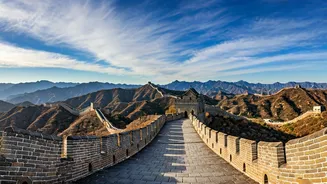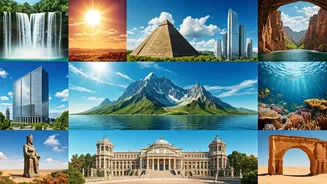The Great Wall
The Great Wall of China is a symbol of human perseverance and architectural brilliance. Spanning thousands of kilometers, it was built over centuries to
defend against invaders. This impressive structure, with its watchtowers and fortifications, showcases the ingenuity of ancient Chinese engineers. Visitors can walk along sections of the wall, experiencing its vastness and appreciating its strategic significance. The wall's enduring presence reflects China's rich history and cultural heritage, making it a must-see for anyone interested in history and architecture.
Petra, Jordan
Petra, carved into sandstone cliffs in Jordan, is an ancient city that captivates with its unique architecture. The Treasury, a stunning facade, is perhaps its most famous feature. This city, once a thriving trading hub, was built by the Nabataean civilization. The intricate carvings and hidden canyons create an otherworldly experience. Petra's isolation and the craftsmanship found there create an enchanting experience. Exploring Petra offers a glimpse into the Nabataean's advanced culture and their ability to integrate architecture with natural landscapes.
The Colosseum
The Colosseum in Rome, Italy, is a testament to the power of the Roman Empire. This massive amphitheater, built nearly 2,000 years ago, once hosted gladiatorial contests and public spectacles. The Colosseum's complex design, with its tiers of seating and underground passages, allowed it to accommodate tens of thousands of spectators. Today, it remains one of the world's most iconic and recognizable landmarks. A visit to the Colosseum transports you back in time, offering insights into Roman society and its entertainment traditions. Its sheer scale and the history it embodies make it an unforgettable experience.
Machu Picchu
Machu Picchu, nestled high in the Andes Mountains of Peru, is an ancient Inca citadel shrouded in mystery. Constructed in the 15th century, its purpose remains a subject of debate. The intricate stonework and panoramic views make it a remarkable architectural feat. The city's location, surrounded by mist-covered mountains, contributes to its mystical allure. Exploring Machu Picchu offers a window into the Inca civilization's sophisticated society and engineering skills. The journey to reach it, whether by hiking the Inca Trail or taking a train, adds to the sense of adventure and discovery.
Taj Mahal
The Taj Mahal in Agra, India, is a breathtaking monument to love. Commissioned by Mughal emperor Shah Jahan in memory of his wife Mumtaz Mahal, it's a stunning example of Mughal architecture. Constructed primarily of white marble, the Taj Mahal is adorned with intricate designs and precious stones. The symmetry and elegance of the structure captivate visitors. The Taj Mahal's serene beauty and romantic symbolism have made it a global icon of love and a must-see destination for travelers from around the world. The stunning reflection on a still day is a sight to behold.
Chichen Itza
Chichen Itza, located on the Yucatán Peninsula in Mexico, is a complex of Mayan ruins that reflect the civilization's advanced understanding of astronomy and mathematics. The iconic pyramid, El Castillo, is aligned with the solstices and equinoxes, showcasing the Mayan people's precise knowledge. Other notable structures include the Temple of the Warriors and the Observatory. Exploring Chichen Itza is like stepping back in time to witness the ingenuity and sophistication of the Mayan people. The site's preservation and the intricate details of its structures provide an enlightening experience for anyone with an interest in history and culture.
Christ the Redeemer
Christ the Redeemer, perched atop Corcovado Mountain in Rio de Janeiro, Brazil, is a symbol of faith and a testament to engineering. This iconic statue, with its outstretched arms, offers breathtaking panoramic views of the city. Construction on the statue took years to complete, with its design and execution reflecting a blend of art and engineering. The statue's significance extends beyond its religious aspect, becoming a symbol of Brazilian culture and hospitality. Visiting Christ the Redeemer offers an inspiring experience, allowing visitors to feel a sense of peace and admire Rio's stunning landscapes.
Eiffel Tower
The Eiffel Tower in Paris, France, is a symbol of the city and a landmark of engineering innovation. Built for the 1889 World's Fair, it was initially met with mixed reactions. Today, it's one of the most visited monuments globally. The tower's intricate iron lattice structure is a feat of engineering, providing panoramic views of Paris from its observation decks. A trip to the Eiffel Tower is a quintessential Parisian experience, allowing visitors to appreciate the city's beauty from new heights. Whether seen up close or from afar, the Eiffel Tower continues to be a symbol of Paris's romantic charm.
Angkor Wat
Angkor Wat, located in Cambodia, is a massive temple complex that embodies the splendor of the Khmer Empire. Built in the 12th century, the intricate carvings and towering structures represent the apex of Khmer architecture. The temple's reflection in the surrounding moats is a famous sight. Angkor Wat serves as a reminder of the Khmer Empire’s cultural and religious significance, offering a rich cultural experience. Exploring the vast complex and appreciating its details, visitors gain insight into the history and heritage of Cambodia. The sunrise view over the temple is a truly unforgettable experience.













